5 big promises made at annual UN climate talks and what has happened since
DUBAI, United Arab Emirates (AP) — When United Nations climate talks wrap up at some point this week in Dubai, big promises will likely be made about how the world is going to combat climate change, caused by the burning of fossil fuels like oil, gas and coal.
Negotiators are debating how fast fossil fuels should be reduced and how a major transition to green energy would be paid for, raising the possibility of a historic agreement.
Previous summits have ended with funds established to help developing countries transition to green energies, pledges to slash pollution and promises to keep people most vulnerable at the center of policy discussions.
But have countries stuck to their word?
Ahead of whatever decisions come from this year’s negotiations, here is a look at five big promises from nearly 30 years of talks, and what’s happened since.
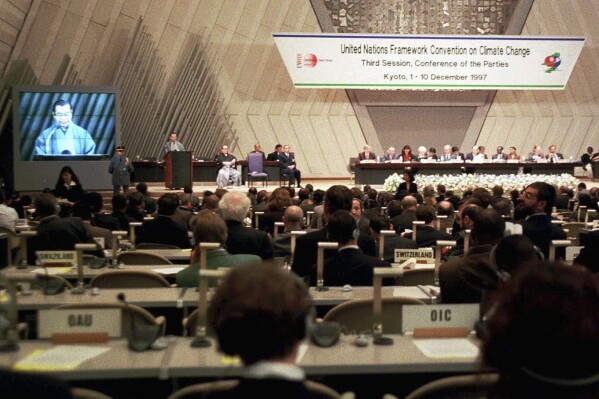
Kyoto Gov. Teiichi Aramaki makes a speech during the opening session of the U.N. Framework Convention on Climate Change, Dec. 1, 1997 in Kyoto, western Japan. (AP Photo/Katsumi Kasahara)
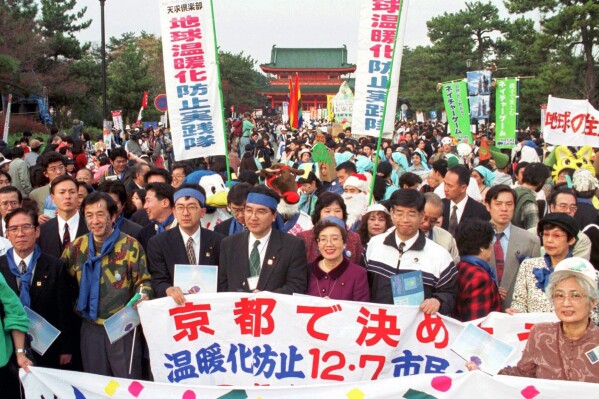
Environmentalists and citizens hold banners calling for reduction of green house gas emissions in front of the Heian shrine in Kyoto, western Japan on Dec. 7, 1997. (AP Photo/Katsumi Kasahara)
EMISSIONS CUTS IN KYOTO
The third climate summit took place in Kyoto, Japan, in 1997 — one of the warmest years recorded in the 20th century.
Known as the Kyoto Protocol, the agreement asked 41 high-emitting countries across the world and the European Union to cut their emissions by a little more than 5% compared to 1990 levels. Emissions cuts can come from many places, from deploying green energies like wind and solar that don’t produce emissions to making things that do, like vehicles with combustible engines, run more cleanly.
Despite the agreement to cut emissions, it was only in 2005 that countries agreed to finally act on the Kyoto Protocol. The United States and China — the two highest emitters both then and now — didn’t sign the agreement.
In terms of sticking to the promises made, Kyoto wasn’t successful. Emissions have increased dramatically since then. At the time, 1997 was the hottest year on record since pre-industrial times. 1998 broke that record, as have more than a dozen years since then.
But Kyota is still considered a landmark moment in the fight against climate change because it was first time so many countries recognized the problem and pledged to act on it.
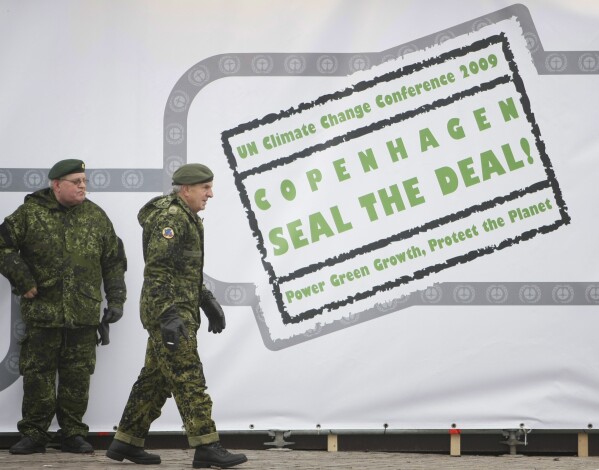
Danish military appear next to a sign reading “Copenhagen Seal the Deal” in the center of Copenhagen, Dec. 12, 2009. (AP Photo/Peter Dejong)
COPENHAGEN’S CLIMATE CASH
By the time the 2009 conference in Denmark came around, the world was capping off its warmest decade on record — which has since been broken.
The summit is widely regarded as a failure for the impasse between developed and developing countries on slashing emissions and whether poorer nations could use fossil fuels to grow their economies. Still, it did see one major pledge: money for countries to transition to clean energy.
Rich countries promised to channel $100 billion a year to developing countries for green technologies by 2020. But they didn’t reach $100 billion by the start of the 2020s, drawing criticism from developing states and environmentalists alike.
In 2022, the Organization of Economic Cooperation and Development said rich countries might have finally met and even exceeded the $100 billion goal. But Oxfam, a group focused on anti-poverty efforts, said it’s likely that 70% of the funds were in the form of loans that actually increased the debt crisis in developing countries.
And as climate change worsens, experts say the funds promised are not enough. Research published by climate economist Nicholas Stern found that developing countries likely need $2 trillion for climate action every year by 2030.
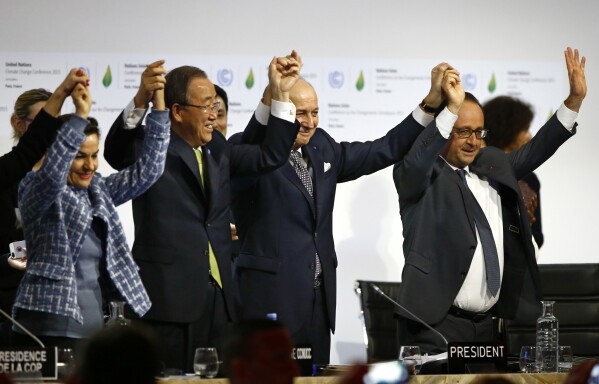
French President Francois Hollande, right, French Foreign Minister and president of the COP21 Laurent Fabius, second right, United Nations climate chief Christiana Figueres, left, and United Nations Secretary General Ban Ki-moon hold their hands up in celebration after the final conference at the COP21, the United Nations conference on climate change, in Le Bourget, north of Paris on Dec. 12, 2015. (AP Photo/Francois Mori)
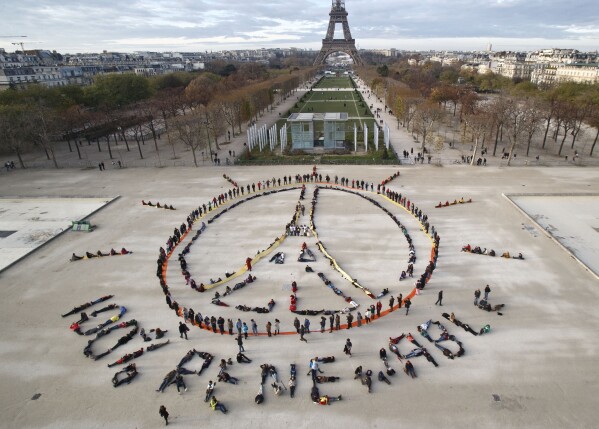
Environmentalist activists form a human chain representing the peace sign and the spelling out “100% renewable”, on the side line of the COP21, United Nations Climate Change Conference near the Eiffel Tower in Paris on Dec. 6, 2015. (AP Photo/Michel Euler)
THE PARIS AGREEMENT
It wasn’t until 2015 that a global pact to fight climate change was adopted by nearly 200 nations, which called on the world to collectively slash greenhouse gases. But they decided it would be non-binding, so countries that didn’t comply couldn’t be sanctioned.
The Paris Agreement is widely considered the single biggest U.N. achievement in efforts to confront climate change. It was agreed upon exactly eight years ago on Dec. 12 to a standing ovation at the plenary. Nations agreed to keep warming “well below” 2 degrees Celsius (3.8 degrees Fahrenheit) since pre-industrial times, and ideally no higher than 1.5 degrees Celsius (2.7 degrees Fahrenheit).
Paris’ legacy continues, with the goal of limiting warming to 1.5 degrees still central to climate discussions. Scientists agree that the 1.5 threshold needs to be upheld because every tenth of a degree of warming brings even more disastrous consequences, in the form of extreme weather events, for an already hot planet. The world hasn’t exceeded the limit set in the Paris agreement — it has warmed around 1.1 or 1.2 degrees Celsius (2 to 2.2 degrees Fahrenheit) since the early 1800s — but is currently well on its way there, unless drastic emissions cuts are made quickly.
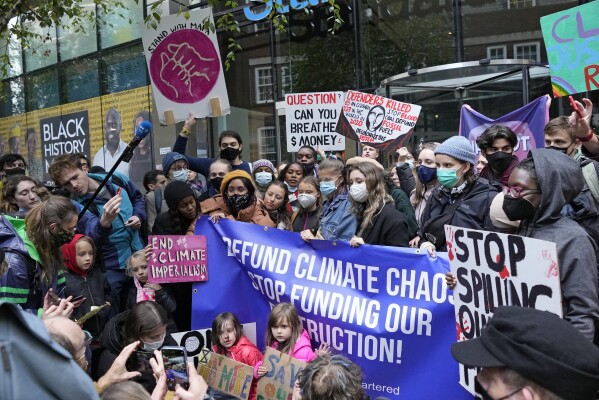
Climate activist Greta Thunberg, center, demonstrates with others in front of the Standard and Chartered Bank during a climate protest in London, England, Oct. 29, 2021. AP Photo/Frank Augstein)
GLASGOW AND COAL
Six years after Paris, global warming had hit such a critical point that negotiators were looking to recommit to the goal of capping warming to the levels agreed in 2015.
Average temperatures were already 1.1 degrees Celsius (1.9 degrees Fahrenheit) higher than pre-industrial times.
The Glasgow summit was postponed until 2021 as the world was emerging from the COVID-19 pandemic. It included mass protests headlined by climate activist Greta Thunberg, who helped lead a global movement of youth activists to demand more action from leaders.
After last-minute disagreements over the language of the final document, countries agreed to “phase-down” coal, less strong than the original idea of a “phase-out.” India and China, two heavily coal-reliant emerging economies, pushed to water the language down.
The burning of coal is responsible for more emissions than any other fossil fuel, approximately 40% of global carbon dioxide emissions. Burning of oil and gas are also major sources of emissions.
So far, countries have failed to deliver on the Glasgow deal. Emissions from coal have slightly increased and major coal-using countries have yet to begin moving away from the dirtiest of fossil fuels.
India is a case in point. It’s dependent on coal for more than 70% of power generation, and plans a major expansion of coal-based power generation capacity over the next 16 months.
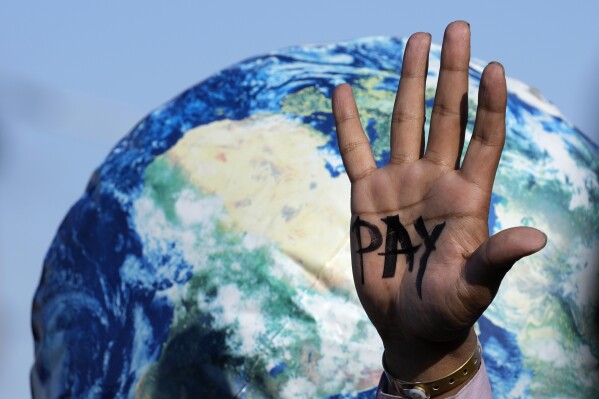
A hand reads “pay” calling for reparations for loss and damage at the COP27 U.N. Climate Summit, Nov. 18, 2022, in Sharm el-Sheikh, Egypt. (AP Photo/Peter Dejong)
LOSS AND DAMAGE IN SHARM EL-SHEIKH
At last year’s climate talks in the Egyptian resort town of Sharm el-Sheikh, countries for the first time agreed to create a fund to help poorer nations recover from the impacts of climate change.
Coming a few months after devastating flooding in Pakistan that killed nearly 2,000 people and caused losses of over $3.2 trillion, COP27 delegates decided to set up the loss and damage fund so that destroyed homes, flooded land and lost income from crops damaged by climate change would compensated.
After disagreements around what the fund should look like, the fund was formally created on the first day of this year’s talks in Dubai. Over $700 million has already been pledged. The pledges — and the amounts the countries choose to commit — are voluntary.
Climate experts say the pledges are just a fraction of the billions of dollars needed, as climate-driven weather extremes such as cyclones, rising sea levels, floods and droughts are increasing as temperatures rise. ___
EDITOR’S NOTE: This article is part of a series produced under the India Climate Journalism Program, a collaboration between The Associated Press, the Stanley Center for Peace and Security and the Press Trust of India.
___
Associated Press climate and environmental coverage receives support from several private foundations. See more about AP’s climate initiative here. The AP is solely responsible for all content.
Disclaimer: The copyright of this article belongs to the original author. Reposting this article is solely for the purpose of information dissemination and does not constitute any investment advice. If there is any infringement, please contact us immediately. We will make corrections or deletions as necessary. Thank you.


